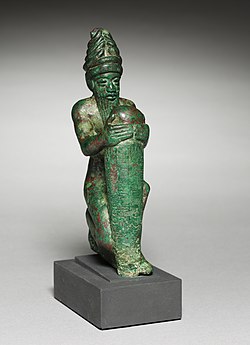
Copper alloys are metal alloys that have copper as their principal component. They have high resistance against corrosion. Of the large number of different types, the best known traditional types are bronze, where tin is a significant addition, and brass, using zinc instead. Both of these are imprecise terms. Latten is a further term, mostly used for coins with a very high copper content. Today the term "copper alloy" tends to be substituted for all of these, especially by museums. [1]
Contents
- Composition
- Brasses
- Bronzes
- Precious metal alloys
- High temperature copper alloys
- See also
- References
- Bibliography
- External links
Copper deposits are abundant in most parts of the world (globally 70 parts per million), and it has therefore always been a relatively cheap metal. By contrast, tin is relatively rare (2 parts per million), and in Europe and the Mediterranean region, even in prehistoric times, it had to be traded considerable distances and was expensive, sometimes virtually unobtainable. Zinc is even more common at 75 parts per million but is harder to extract from its ores. Bronze with the ideal percentage of tin was therefore expensive, and the proportion of tin was often reduced to save cost. The discovery and exploitation of the Bolivian tin belt in the 19th century made tin far cheaper, although forecasts for future supplies are less positive.
There are as many as 400 different copper and copper alloy compositions loosely grouped into the categories: copper, high copper alloy, brasses, bronzes, cupronickel, copper–nickel–zinc (nickel silver), leaded copper, and special alloys.



